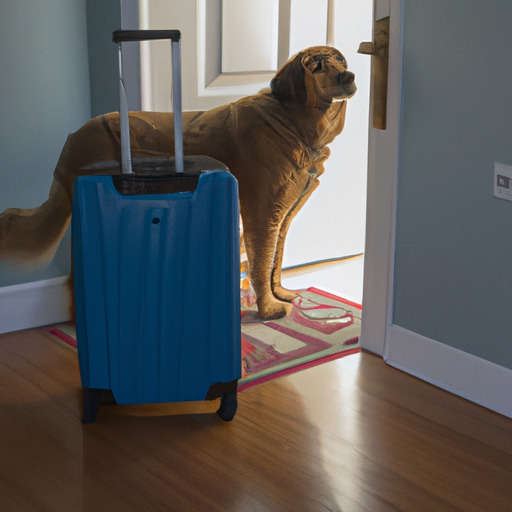Phone:
(701)814-6992
Physical address:
6296 Donnelly Plaza
Ratkeville, Bahamas.


In this article, you will learn about how long you can board a dog and what factors may affect the duration of their stay. Boarding a dog can be a convenient option when you need to travel or have other commitments that prevent you from taking care of your furry friend. Generally, most boarding facilities offer short-term stays ranging from a few days to a few weeks. However, the length of time you can board a dog can vary depending on the facility and their policies, as well as the specific needs and requirements of your dog.


When determining how long you can board a dog, it’s important to consider factors such as the dog’s behavior, health, and vaccination status. Some dogs may require more frequent exercise or socialization, while others may have special dietary needs or require medication. Additionally, some facilities may have restrictions on long-term boarding or may require additional documentation, such as proof of vaccinations. It’s always best to communicate with the boarding facility in advance and discuss your dog’s specific needs to ensure a comfortable and stress-free stay for your furry companion.
Table of Contents
When it comes to traveling or going on vacation, dog owners are often faced with the dilemma of finding the right boarding facility for their furry friends. There are several factors that determine the length of time you can board your dog, including their health and age, the duration of your travel, and the policies of the boarding facility. In this article, we will delve into these factors and provide you with important considerations and tips to ensure a comfortable and safe boarding experience for your beloved pet.
One of the key factors that determine the boarding period is the health and age of your dog. Healthy dogs without any underlying medical conditions can typically be boarded for longer periods of time compared to dogs with health issues. It is important to provide your dog’s vaccination records to the boarding facility to ensure they are up to date and protected against diseases. Aging dogs may require special care and attention, so it’s best to discuss their specific needs with the boarding facility.
Another factor to consider is the duration of your travel. If you’re going away for a short period, such as a weekend trip, you can opt for short-term boarding. However, if your travel extends for a longer period, such as a month-long vacation, you may need to consider long-term boarding options. It’s important to plan ahead and book your dog’s boarding well in advance to secure their spot, especially during peak travel seasons.
Each boarding facility will have its own policies regarding the maximum boarding time for dogs. Some facilities may have a set limit, while others may be more flexible. It is crucial to inquire about these policies when searching for a boarding facility, as they may influence your decision on how long you can board your dog. Make sure to fully understand and abide by the facility’s policies to ensure a smooth and stress-free boarding experience.
Short-term boarding refers to a dog’s stay at a boarding facility for a relatively shorter duration, usually ranging from a few hours to a few days. This option is suitable for dog owners who need temporary care for their pets, such as during a day trip or short weekend getaway. Most boarding facilities offer daily or overnight boarding options for short-term stays, providing your dog with a safe and comfortable environment.


Long-term boarding, on the other hand, is more suitable for dog owners who require extended care for their pets. This can range from a week to several months, depending on the owner’s travel duration. Long-term boarding is an excellent choice for those going on extended vacations or experiencing life events that require their absence for an extended period. It ensures that your dog receives proper care, attention, and socialization while you are away.
Daily boarding is ideal for dog owners who need temporary care for their pets during the day. This option is especially beneficial for individuals who work long hours or have commitments that prevent them from being with their dogs during the day. Daily boarding facilities typically provide a safe and supervised environment, where dogs can enjoy playtime, socialize with other dogs, and receive necessary attention and care.
Overnight boarding is a popular choice for dog owners who require care for their pets overnight or over a weekend. This option allows your dog to have a comfortable place to sleep, socialize, and receive proper care during the night. Most overnight boarding facilities provide cozy sleeping areas, feeding schedules, and even special services such as grooming or access to outdoor playgrounds.
For dog owners going on week-long vacations or business trips, weekly boarding can be a suitable option. This ensures that your dog receives consistent care and attention throughout your absence. When considering weekly boarding, it is essential to provide specific instructions to the facility regarding your dog’s feeding schedule, medication (if applicable), and any special needs they may have.
Monthly boarding is typically chosen by dog owners who are going on extended vacations or who have commitments that require them to be away for an extended period. Monthly boarding facilities ensure that your dog is well taken care of and given ample socialization opportunities to prevent them from feeling lonely or stressed during your absence. It’s important to maintain good communication with the boarding staff throughout the boarding period to ensure your dog’s well-being.
Before boarding your dog, there are a few preparations you need to make to ensure a smooth transition for your pet:
Most boarding facilities require dogs to be up to date with their vaccinations to prevent the spread of contagious diseases. Make sure you have your dog’s vaccination records on hand and provide them to the boarding facility at least a week before their stay. This will ensure that your dog is protected and that they can be accommodated at the facility.
Prior to boarding, it is recommended to take your dog for a visit to the boarding facility. This will allow them to become familiar with the surroundings, the staff, and the other dogs that may be staying there. It can help alleviate any anxiety or stress your dog may have and provide you with peace of mind knowing that they will be comfortable during their stay.
If your dog has any specific dietary needs, medication requirements, or behavioral issues, it is important to inform the boarding facility in advance. They will need to know how to properly care for your dog and ensure their well-being. Providing clear and concise instructions will help minimize any potential issues and ensure that your dog receives the appropriate care and attention they need.
Choosing a reputable boarding facility that provides a comfortable and enriching environment for your dog is crucial. Here are some key amenities to look out for when selecting a boarding facility:
A good boarding facility should provide a comfortable and clean sleeping area for your dog. Whether it’s a cozy kennel or a private room, it’s important to ensure that your dog has a comfortable place to rest and sleep throughout their stay.
Access to outdoor play areas is essential for dogs to get exercise and enjoy fresh air. A boarding facility with well-maintained outdoor playgrounds, where dogs can run, play, and socialize, will provide a more enriching experience for your pet.


Some boarding facilities offer grooming services, including baths, nail trims, and coat brushing. This can be a convenient option if you want your dog to receive grooming services during their stay.
A reputable boarding facility should provide ample socialization opportunities for dogs to interact with other dogs and receive attention from trained staff. This can help prevent boredom and promote positive behavior during their stay.
It’s important to be aware of the signs of stress in boarded dogs, as it can indicate that your pet is not adjusting well to their surroundings. Here are some common signs to watch out for:
While some level of barking is normal, excessive and persistent barking can be a sign of stress or discomfort. If you receive feedback from the boarding facility about your dog’s barking, it’s worth addressing the underlying cause and discussing strategies to alleviate their stress.


A sudden loss of appetite or refusal to eat can be an indication that your dog is feeling stressed or anxious. It’s important to communicate any changes in your dog’s eating habits to the boarding facility, as they may need to adjust their care accordingly.
If your dog becomes unusually withdrawn, avoids social interaction, or displays signs of depression, it may be a sign of stress. Discuss your concerns with the boarding facility and ask for updates on your dog’s behavior to ensure their well-being.
If traditional boarding doesn’t seem like the right fit for your dog, there are alternative options to consider:
Hiring a pet sitter to come to your home and take care of your dog can be a less stressful alternative to boarding. Your dog can remain in their familiar environment, and the pet sitter can provide personalized care and attention.
In-home boarding is another option where your dog stays with a trusted individual or family in their home. This can be a more intimate and homely experience for your dog, allowing them to receive one-on-one attention and care.


Choosing the right boarding facility is crucial to ensure your dog’s safety and well-being. Here are some steps to follow when selecting a reputable facility:
Start by researching online reviews and recommendations from other dog owners. Hearing about other people’s experiences can provide valuable insight into the quality of care provided by the facility.
Schedule a visit to the facility to assess its cleanliness, safety measures, and overall environment. Look for proper ventilation, clean and spacious kennels or rooms, and well-maintained play areas. Ensure that the facility has protocols in place to handle emergencies and is equipped to address any potential health issues that may arise.
During your visit, take the opportunity to ask the staff questions about their experience, training, and how they handle different situations. A knowledgeable and attentive staff can provide better care for your dog and address any concerns you may have.
Boarding your dog can be a convenient solution when you are unable to provide care while you’re away. By considering your dog’s health and age, your travel duration, and the policies of the boarding facility, you can determine the optimal boarding period for your pet. Make sure to thoroughly research and choose a reputable boarding facility that provides a comfortable and safe environment for your dog. By preparing your dog adequately before their boarding, providing necessary instructions, and maintaining good communication with the facility, you can ensure a stress-free and enjoyable experience for your beloved pet. Remember, each dog is unique, so it’s important to consider their individual needs and tailor their boarding experience accordingly.

